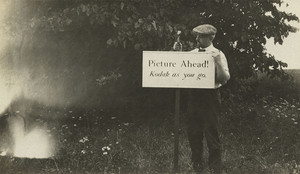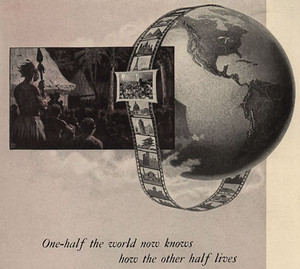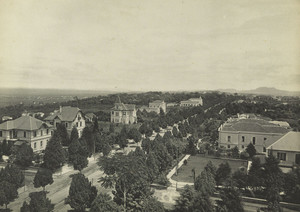
Book: Picture Ahead: A Kodak e a construção do turista-fotógrafo
Massive marketing campaign: the photographer likened to a hunter in 1900…Book: Picture Ahead: A Kodak e a construção do turista-fotógrafoPresent on identification documents, in print publications, and on social networks, photographs have become essential to the functioning of modern society. In the book Picture Ahead: A Kodak e a construção do turista-fotógrafo (Picture Ahead: Kodak and the Construction of the Tourist-Photographer), photography and visual arts professor Lívia Aquino, coordinator of the graduate photography program at the Armando Álvares Penteado Foundation (FAAP) in São Paulo, shows that this omnipresence of images emerged after a long process of camera popularization in which Kodak, the American camera company, played a decisive role.
Invented in the first half of the nineteenth century, photography revolutionized collective memory: thanks to cameras, humans now had the opportunity to create an objective support for their memories. Professional photographers became more widespread, and wealthy families began to fill their homes with portraits of themselves in solemn poses.
“Little by little, photography became a part of everyday life, and visual narratives, such as family photo albums, were created,” notes historian Solange Ferraz de Lima, director of the Paulista Museum of the University of São Paulo (MP-USP). “With records of family rites (baptisms, weddings, and graduations) and of times of transition (births, funerals, and separations), these narratives reinforced both personal identities and community bonds and gave individuals an awareness of the changes brought about by time.”

Book: Picture Ahead: A Kodak e a construção do turista-fotógrafo
…Kodak slogan in 1920Book: Picture Ahead: A Kodak e a construção do turista-fotógrafoThe spread of photography entered a new phase in 1888, when the American George Eastman invented a cheaper and easier-to-use device: the Kodak camera. With it, people were able to produce their own photos, without requiring professionals. In the same time period, tourist vacations—formerly available to a privileged few—were becoming more affordable to people from other social classes thanks to the development of new methods of transportation (steam ships, trains, and automobiles) and also as a result of the new concept of paid vacations for salaried workers.
The founder of Kodak realized that there was a huge market for portable cameras, and the company invested heavily in advertising campaigns to convince the public that vacations that were not photographed were wasted vacations. Thanks to photography, every family could show off their status as tourists.
In her book, Aquino shows how photography and tourism became interconnected as objects of desire. “Photography and tourism have disciplined us,” argues Aquino, whose book is the result of her doctoral dissertation, completed at the University of Campinas (UNICAMP). According to Aquino, planning the trip, photographing it to exhaustion, taking the film to be developed, building albums or slides, and gathering friends and family together to show them the photos were practices that came to become a family ritual. “They are cultural norms that don’t seem like norms,” she says, “because people accept them voluntarily and are motivated by their eagerness for social recognition.”

Book: Picture Ahead: A Kodak e a construção do turista-fotógrafo
Marketing encouraged people around the world to carry a camera, as shown in these ads from 1919…Book: Picture Ahead: A Kodak e a construção do turista-fotógrafoBecoming an amateur photographer had benefits for one’s self-image. The Kodak ads presented photographers as fearless, gallant men who were “hunters” of images. “George Eastman hunted wild animals and had quite a few trophies. He said photography replaced hunting. That was the foundation for amateur photography. His first slogan was ‘You pull the trigger, and we’ll do the rest.’” The Kodak campaigns divided the world into people who saw and people who were seen, as suggested in the slogan “Half of the world now knows how the other half lives.” Having a camera was a sign of social distinction.
The identification of the photographer as a hunter had an impact on popular imagination, and these professionals became the main characters in a number of works of fiction. Some of these works were studied by Gabriela Coppola in her dissertation “Através do fotógrafo: Intercorrências do ser, agir e olhar em narrativas de personagens fotógrafos” (Behind the Photographer: Interactions between Being, Acting, and Looking in the Narratives of Photographer Characters), which was defended at the University of Campinas (UNICAMP) in 2015. Coppola tells Pesquisa FAPESP that the fascination inspired by photographers comes from their power to conserve “people’s notions of time, their memories, and the time and memories of events.” There is another side to this as well: photographers can capture someone’s image the way he or she most desires to be seen; however, they are equally capable of destroying that person’s image. In the narratives involving photographers, the characters (such as the protagonists in the films Blow Up by Michelangelo Antonioni, Palermo Shooting by Wim Wenders, and Spider Man by Sam Raimi) are all light-skinned Westerners, perhaps because “the history of photography itself is largely represented by men with these characteristics,” Coppola points out. The portrait is the same in Brazil: of the 11 telenovelas on the Globo Television Network involving photographers, these roles were almost always played by white men.
Photos in Museums
In the First Brazilian Republic period (1889-1930), cameras were still relatively expensive, explains historian Zita Possamai, professor at the Federal University of Rio Grande do Sul (UFRGS). Possamai is the author of the PhD dissertation titled “Cidade fotografada: Memória e esquecimento nos álbuns fotográficos de Porto Alegre, décadas de 1920 e 1930” (The Photographed City: Memory and the forgotten in photo albums from the city of Porto Alegre in the 1920s and the 1930s), which was defended at UFRGS in 2005. Possamai notes that “the camera was an object of value among household belongings and was certainly restricted to the upper echelons of the society.”

Book: Picture Ahead: A Kodak e a construção do turista-fotógrafo
…and from 1960Book: Picture Ahead: A Kodak e a construção do turista-fotógrafoThis ostentation became more subtle as cameras became more widespread. “In the nineteenth century, stiff poses in carefully chosen locations were not only the result of technical conditions; they were meant to clearly expose the social status held by each person photographed. Later, ‘candid’ photographs, which became a trend in the twentieth century, tended to blur these lines of distinction, though they did not eliminate them completely,” Ferraz de Lima explains. Portraits lost their solemn air, which had been inspired by portraits by academic painters in the nineteenth century, and acquired a more natural tone.
The democratization of photographs did not only affect portraits: the world came to be seen in a less symmetrical and more chaotic way. In the book Fotografia e Cidade (Photography and the City), published by the Brazilian publisher Mercado das Letras in 1997, Ferraz de Lima and historian Vania Carneiro de Carvalho, from the MS-USP, analyzed photo albums from two time periods: the first two decades of the twentieth century and the city of São Paulo’s 400th anniversary celebration in 1954. Ferraz de Lima says that, in the First Republic period, classic photos from Swiss-born Brazilian photographer Guilherme Gaensly valued “straight lines and uniformity based on diagonal perspectives that promoted the representation of photographic planes using spatial contiguity,” as represented by lines of trees, sidewalk curbs, and trolley tracks.
In the images from the 1950s, the city of São Paulo became more fragmented: “The photographic planes are represented by overlap, and the effects of light contrasts and scales reflect the characteristics of modern architecture seen in the buildings in downtown São Paulo,” Ferraz de Lima and Carneiro de Carvalho write in the book. In summary: “Verticalization, urban citizens in movement, and a city continually under construction are themes considered par excellence in the albums in the 1950s, which created a dialogue with a formal repertoire of modern photography that contrasted with the rationally arranged city that the albums of the 1910s represented.”

Brazilian National Library Digital Collection
Photo of Avenida Paulista (1902) by Guilherme Gaensly shows a rationally arranged cityBrazilian National Library Digital CollectionThe new perspective brought about by photography, however, took time to be embraced by art-related institutions. Photography was introduced into art museums in the mid nineteenth century, but only as a tool for the reproduction and diffusion of works of art,” explains art historian Helouise Costa from the Museum of Contemporary Art of the University of São Paulo (MAC-USP).
In the nineteenth century, photographers began to point out the qualities of the new medium, but they could not convince the institutions, which saw attributes in the mechanical and reproducible nature of photography that were incompatible with art. This conflict led modernists to try to give an esthetic air to photographs by limiting their distribution and highlighting “the ideas of originality and authorship,” Costa describes.
Nevertheless, it would take decades for photography to make its way into museums. The first was the Museum of Modern Art in New York, which began to hold photography expositions in 1932 and which created a photography department in 1940. According to Costa, photography was incorporated into modern art in the 1960s, both as part of the development of pop art (which made reproducibility the foundation of its poetic nature) and in the different practices of conceptual art, which focused on the autonomy of works of art. “In Brazil, the recognition of photography by the art world began with the establishment of modern museums in the late 1940s and the creation of the São Paulo Art Biennial in the early 1950s.”
With the Internet and cell phones, digital albums and photos of leisure activities have taken over the world. “It’s important to understand,” says Ferraz de Lima, “that this present-day saturation of digital images shared on social networks has a history; it’s based on former cultural practices.” Kodak has all but disappeared, but the device that gave rise to social practices associated with photography has survived. “The device survived; it manifested into other media,” notes Aquino. “When we open our timeline on Facebook, it reminds us what kinds of things we have to remember in the form of a slideshow.”
Project
The tourist’s imagination: Relationships between photography and memory (nº 10/07961-8); Grant Mechanism PhD grant; Principal Investigator Iara Lis Franco Schiavinatto (UNICAMP); Grant Beneficiary Lívia Afonso de Aquino; Investment R$127,003.87.
Scientific Articles
COSTA, H. e LIMA, S. F. Da fotografia como arte à arte como fotografia: A experiência do Museu de Arte Contemporânea da USP na década de 1970. Anais do Museu Paulista. V. 16, No. 2. July-Dec. 2008.
POSSAMAI, Z. R. Narrativas fotográficas sobre a cidade. Revista Brasileira de História. V. 27, No. 53. Jan.-June 2007.
CARVALHO, V. C. et al. Fotografia no museu: O projeto de curadoria da coleção Militão Augusto de Azevedo. Anais do Museu Paulista. On-line. 1997.
Books
AQUINO, L. Picture ahead: A Kodak e a construção do turista-fotógrafo. Self-published with the support of the Funarte Marc Ferrez Photography Award, 2016, 264 p. Available for download free of charge
LIMA, S. F. e CARVALHO, V. C. Fotografia e cidade: Da razão urbana à lógica do consumo. Álbuns de São Paulo (1887-1954). Campinas: Mercado das Letras, 1997, 272 p.